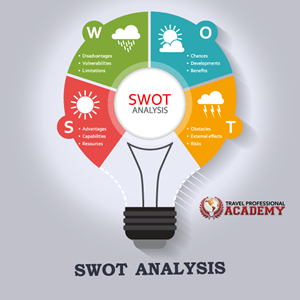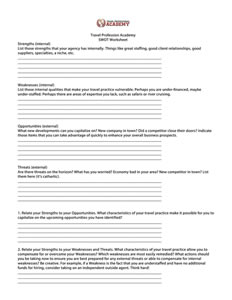Now is a good time to keep a promise to yourself and conduct a SWOT analysis for your travel business. The SWOT acronym indicates Strengths, Weaknesses, Opportunities, and Threats. The traditional SWOT looks at Strengths and Weaknesses of a business (internal factors) and tries to thereby ascertain the relationship with Opportunities and Threats (factors external to the agency). Doing an annual SWOT analysis is a good prerequisite to a marketing plan and assists with developing the appropriate goals for your travel practice. One of the most important aspects of a SWOT analysis for travel agencies is very simply the act of planning: the analysis makes you take a good look at your positioning in the market. Each component of the SWOT analysis bears a relationship to the others. Each of your strengths will give rise to opportunities or the capacity to exploit an opportunity. Likewise, your strengths allow your travel practice to better confront the threats on the horizon or compensate for weaknesses.

Strengths
Your Strengths are those aspects of your business profile that give you a distinct market advantage and upon which you can capitalize in your marketing plan. The category of Strengths goes to those qualities internal to your travel practice, not to external factors like the economy.
Pull together into a list those qualities which are unique to your travel practice as well as those which you might share with your competitors. Strengths build upon one another and a set of qualities in combination may contribute more than a similar set with a key element missing or in differing proportions. Begin with your unique selling point: why would clients turn to you as opposed to your competition? What is unique about your agency? What qualities set you apart? Perhaps it is your niche in the marketplace. Perhaps it is the personality of your agents. Your strength may be in your legacy – the reputation you have built over the years. Treat your SWOT analysis as a brainstorming session. Participants should feel free to name any quality that resonates as a strength.

Be candid and honest in your assessment. Only list those qualities that are true strengths. For example, listing your “website” as a strength is only valid if indeed it is a real asset to your business. A poorly constructed or conceived website could in reality be a weakness, projecting a poor image and costing you business.
Here is a sample listing of possible strengths for a travel agency:
- Niche destination knowledge of Africa
- Over 100 countries visited by combined agents
- Excellent supplier relationships
- Strong consortia membership
- Reputation in the marketplace is strong
- Well placed in community civic organizations
- Good press contacts
- Adequate financial resources
- Good location
- Excellent customer list
- Destination Specialist designations
Note that this is a list of features of the agency. A good additional exercise with this list is to translate each feature in a list of benefits – what does each strength mean to clients? In fact, that will be a key exercise when we look at the company’s opportunities. But first, we must do a good job at assessing the less pleasant aspect of the travel agency’s weaknesses.
Weaknesses
An analysis of the weaknesses of any travel consulting business by its owner requires an extraordinary degree of both honesty and humility. It is not easy to admit where your program has weaknesses. Further, from the perspective of an insider, it is often difficult to even detect some weaknesses. For that reason, the input and constructive criticism of outsiders is an invaluable asset. It is likewise important to allow your insiders, employees and associates to openly point out deficiencies during the SWOT analysis. The customer or associate who provides constructive criticism is doing you a real favor, so be prepared to accept critical input in the spirit in which it is given!
Every travel agency has inherent weaknesses. Being too small is a weakness – there are some opportunities that cannot be taken on by a one or two-person office. Being too large can be a weakness if the size of your travel agency results in slow decision-making or too-rigid policies. Too few personnel, a poor location, outdated collateral can all be considered weaknesses. A lack of experience is a weakness, as is a lack of capital. Remember that in the context of a SWOT analysis, weaknesses refer to internal issues, not to externals such as a local competitor (we will address the competition under “Threats”).
With reference to the other components of your SWOT analysis, weaknesses make it harder to capitalize on Opportunities and make the travel agency more vulnerable to Threats. Weaknesses drain the inherent power of Strengths. It is easy to see the need to correctly identify weaknesses and to find a remedy in as speedy a manner as possible.
Here is a sample listing of weaknesses in our hypothetical travel agency:
- No experience with niche cruises.

- Only four agents – two of whom are new to the industry
- An aging cookie-cutter website with little traffic and no real interest
- Irregular company newsletter publication
- No understanding of social media
- Small historical emphasis and budget for marketing
- No substantial group leader program
- Low year-on-year growth patterns
The identification of the travel agency’s weaknesses naturally will be followed on by a program to shore up and remedy the issues as identified. Immediately, it is apparent that growth will be a key target area and that assets need to be put toward marketing and product knowledge, perhaps with some fam trips with niche cruise companies. Next, we will turn our attention to the opportunities in the marketplace, and identify how the travel agency’s strengths will allow the company to exploit them while shoring up some of the agency’s weaknesses.
Opportunities
We know our hypothetical travel agency’s strengths and weaknesses. Now, it is time to think about the opportunities that the market is presenting. Opportunities are external to the company and present the possibility for profit and growth IF the company can position itself to take advantage of the opportunity – which is precisely what the SWOT analysis is designed to do. It is almost certain that the company will not be able to take advantage of every possible opportunity, so identifying the ones with the most potential is critical.
Analyzing opportunities requires a good working knowledge of local, regional, and national trends. Changes in the public perception of particular destinations, pop culture, improving economic conditions, pent-up demand or changes in local demographics can have real impact on a travel agency’s opportunities. For example, the upcoming release of a movie can increase demand for a particular set location as did Lord of the Rings for New Zealand. Getting ahead of that demand curve might suggest a marketing campaign or a set of destination specialist courses. Positioning a travel agency to take advantage of the building of a new local senior citizen community is the type of advance planning that could be important to growth.
New company in town? Opportunity! Competition close down over the past year releasing both clients and new personnel? Opportunity!
A good exercise is to look at your list of Strengths and determine whether they reveal any possible unexploited Opportunities. For example, do any of your associates have destination specialties that could be turned into opportunities? Do your press contacts suggest a particular strategy with regard to public relations opportunities? Alternatively, examine your travel agency’s weaknesses. What if you eliminated one of them – would that present a new opportunity?
Here is a list of possible opportunities for our hypothetical agency:
- Pent up demand for travel after a year of Covid-19

- Concerns over terrorism create domestic travel demand
- ABC Travel, a competitor, looks weak – no marketing during Covid – laid off employees
- Series of articles in local paper on River Cruising got a lot of attention
- New Senior center has inquired about group travel
It is easy to see that opportunities may be fleeting. For that reason, a SWOT analysis cannot be treated as a static plan but should be considered alive and organic. Not all opportunities can be anticipated by the travel agent and therefore some room must be left for contingency and unexpected opportunities.
Threats
I am almost hesitant to discuss threats to your agency or travel practice. Most of us too easily imagine all the possible perils that await at every turn, and we have spent the past year on the edge. It keeps us up at night. Worse yet, threats can cause even the most stalwart travel agent to do the worst possible thing – nothing. Threats have a way of making business people pull in their resources and withdraw from the marketplace. The value of a SWOT analysis, however, is to recognize threats ahead of time and to counter weaknesses and marshal our strengths so that we can not only exploit opportunities but can counter, prepare for and diminish threats early on.
Threats are external to your agency. They might come in the form of a new competitor, a bad national economy or conditions that are completely local to your community. A terrorist attack anywhere in the world would be a threat as it might keep people from traveling. A resurgence of swine-flu is a threat we all face this fall. Any of these events or circumstances would threaten an agency’s ability to exploit opportunities, to grow, and prosper.
Here is a list of possible threats to our hypothetical agency:
- Covid has dampened demand for European travel

- The possible shut-down of a furniture manufacturer in town may cause economic distress locally
- Political chaos is causing market uncertainty
- The competitor across town just affiliated with a large industry franchise with lots of marketing dollars
However, each of these threats also suggests a course of action. New competitor? Let’s look at how we can better bootstrap market. Bad economy? Adjust our marketing strategy to fit the mood. Threat of terrorism or extended Covid – let’s better communicate, educate our community and suggest alternative destinations. Taking action is the key to confronting and dealing with threats. We have identified our strengths – let’s use them in defense of our travel practices!
The real value of a SWOT analysis is the opportunity it affords to closely examine your business, to work on your business instead of in your business. Examining the opportunities and preparing for the threats, dealing with weaknesses and remembering where your strengths are to be found is an invaluable exercise in planning. Click on the image below to download our SWOT Worksheet and work through your own compilation of your Strengths, Weaknesses, Opportunities, and Threats.




